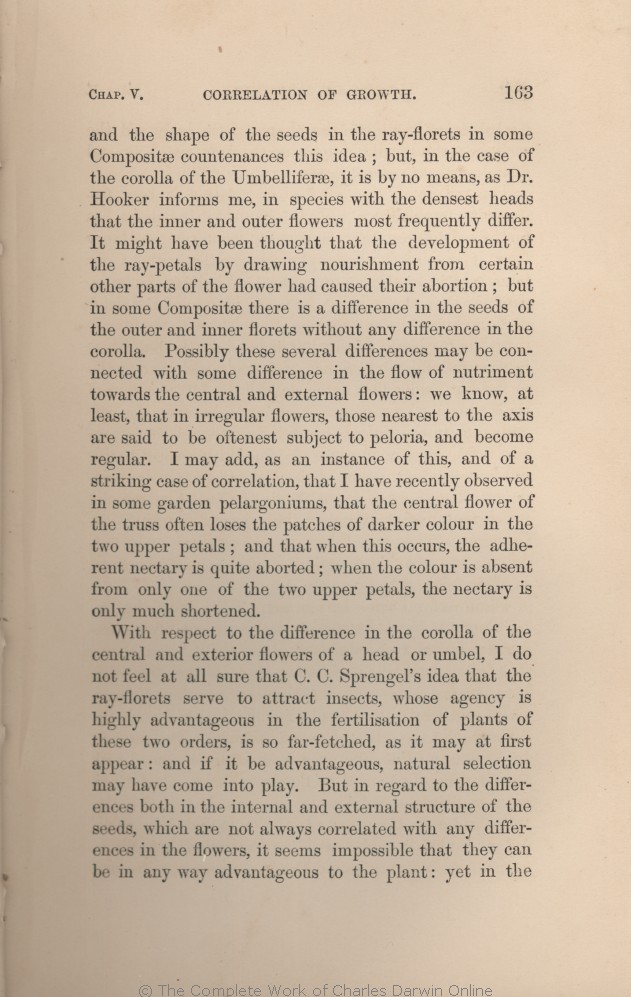of the
seeds in the ray-florets in some Compositæ countenances this idea; but, in the case | seeds in the ray-florets in some Compositæ countenances this idea; but, in the case 1859 1860 1861 1866 |
| involucra on the florets, or to their mutual pressure, and the shape 1869 1872 |
| corolla of 1859 1860 1861 1866 |
| seeds in the ray-florets of some Compositæ countenances this idea; but with 1869 1872 |
| in 1859 1860 1861 1866 | | the 1869 1872 |
| that the inner and outer flowers 1859 1860 1861 1866 |
| which 1869 1872 |
| differ. 1859 1860 1861 1866 |
| differ in their inner and outer flowers. 1869 1872 |
| certain other parts of the flower had 1859 1860 1861 1866 |
| the reproductive organs had 1869 |
| the reproductive organs 1872 |
| caused 1859 1860 1861 1866 1869 | | causes 1872 |
| in 1859 1860 1861 1866 |
| this can hardly be the sole cause, for in 1869 1872 |
| there is a difference in 1859 1860 1861 1866 |
| OMIT 1869 1872 |
| without 1859 1860 1861 1866 | | differ without 1869 | | differ, without 1872 |
| Possibly 1861 1866 1869 1872 | | Possibly, 1859 1860 |
| differences 1859 1860 1861 1869 1872 | | differ- ences 1866 |
| some 1859 1860 1861 1866 | | the 1869 1872 |
| difference 1859 1860 1861 1866 | | different 1869 1872 |
| in the 1859 1860 1861 1866 | in the 1869 1872 |
| in 1859 1860 1861 1866 | | with normally 1869 | | with 1872 |
| said to be oftenest 1861 1866 |
| oftenest 1859 1860 |
| most 1869 1872 |
| and become regular. 1859 1860 1861 1866 |
| that is they become symmetrical. 1869 |
| that is to become abnormally symmetrical. 1872 |
| this, 1859 1860 1861 1866 1869 | | this 1872 |
| and of 1859 1860 1861 1866 1869 |
| fact, and as 1872 |
| I have recently observed in some garden pelargoniums, that 1859 1860 1861 1866 |
| I have recently observed in many pelargoniums, that 1869 |
| in many pelargoniums, the two upper petals in 1872 |
| the 1859 1860 1861 1866 1872 | | in the 1869 |
| truss 1859 1860 1861 1866 1872 | | truss, 1869 |
| often loses the patches of darker colour in the two upper petals; and that 1859 1860 1861 |
| often loses the patches of darker colour in the two upper petals; and that, 1866 |
| the two upper petals often lose their patches of darker colour; and 1869 |
| often lose their patches of darker colour; and 1872 |
| aborted; 1859 1860 1861 1866 1872 | | aborted. 1869 |
| when the 1859 1860 1861 1866 |
| When the 1869 |
| the central flower thus becoming peloric or regular. When the 1872 |
| only 1859 1860 1861 1866 |
| not quite aborted but is 1869 1872 |
|
With respect to the
difference in | difference in 1859 1860 1861 1866 | | development of 1869 1872 |
| corolla 1859 1860 1861 1866 1869 | | corolla, 1872 |
| of the central and exterior flowers of a head or umbel, I do not feel at all sure that C. c. 1859 1860 1861 |
| of the central and exterior flowers of a head or umbel, I do not feel at all sure that c. c. 1866 |
| in the central and exterior flowers, 1869 |
| OMIT 1872 |
| Sprengel's 1859 1860 1861 1866 1872 | | Sprengels 1869 |
| in 1859 1860 1861 1866 |
| or necessary for 1869 1872 |
| plants of these two orders, is so far-fetched, as it may at first appear: 1859 1860 1861 |
| plants of these two orders, is so far-fetched as it may at first appear: 1866 |
| these plants, is highly probable; 1869 1872 |
| it be advantageous, 1859 1860 1861 1866 |
| so, 1869 1872 |
| in regard 1859 1860 1861 1866 | | with respect 1869 1872 |
| differences both in the internal and external structure of the seeds, which are not always correlated with any differences in the 1859 1860 1861 |
| differences in the 1866 |
| seeds, it seems impossible that their differences in shape, which are not always correlated with any difference in the 1869 1872 |
| flowers, it seems impossible that they 1859 1860 1861 1866 |
| corolla, 1869 1872 |
| advantageous to the plant: 1859 1860 1861 1866 |
| beneficial: 1869 |
| beneficial; 1872 |
|









